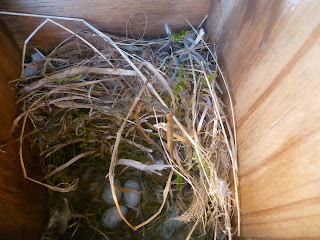I watch and record the birds in my garden every week for the
BTO's Garden Birdwatch Scheme. I don't blog about the results often, but this last week has been so good I wanted to share the news and a few photos.
Chaffinches,
Greenfinches and
Goldfinches are regular visitors to the garden throughout the year, with weekly winter totals averaging 15, 5 and 20 respectively. This year, however, these 3 species have been joins by their much less common cousins;
Siskin,
Lesser Redpoll,
Brambling and
Bullfinch.
Siskin in particular, have been very numerous this winter, with sightings in every week since the end of January. Numbers started off quite low, with 1s and 2s, but have steadily built up, culminating in a superb 14 birds this morning!
4 of today's 14 Siskins
Lesser Redpolls are not so numerous, but have again been present on and off throughout much of the Winter/early Spring.The maximum count so far being 6 present on 2nd April, including this very colourful male bird.
Lesser Redpoll and male Greenfinch
Bramblings were first recorded in mid January, with just 1 present. This built up to 3 birds; 2 males and 1 female, in February, until this afternoon, when I looked out and saw 7 birds, 2 males and 5 females, feeding on the lawn. This is my highest ever count!
Brambling
Bullfinches are the least common finch species in the garden, with just a few sightings each year. So far this year, I've recorded them on just s couple of occasions, including a pair today. Unfortunately, neither bird would pose for a photo.
Along with all the finches, the garden also attracts several other species on a daily basis, including
Dunnock (3 today, singing and wing flicking to each other),
Blue Tit (2),
Coal Tit (1),
Great Tit (1),
Blackbird (4; 2 males and 2 females, 1 of which was collecting nesting materials),
House Sparrow (1 male and 2 females, inspecting the nest box),
Starling (4, including 2 nest building in the box),
Collared Dove (1) and
Woodpigeon (7, including the year's first juvenile bird!).
Juvenile Woodpigeon (complete with downy chest!)






























